University of Technology, Sydney: Burj Khalifa Project Report
VerifiedAdded on 2022/11/14
|9
|2183
|174
Report
AI Summary
This report provides a detailed analysis of the Burj Khalifa project, focusing on its project management aspects. It begins with an overview of the project, highlighting its significance as a global architectural marvel and the challenges faced during its design and construction. The report then explores the project's objectives, deliverables, and key stakeholders, including Emaar Properties, the government, and various consultants and contractors. It examines the anticipated benefits, such as increased tourism and economic growth. The analysis delves into project integration, scope, time, and cost, including the Integrated Project Delivery (IPD) approach used and its advantages and disadvantages. The report also discusses the project's planning, management, and critical aspects like risk management. The report then concludes by assessing the project's achievements and failures, providing a comprehensive understanding of the Burj Khalifa's project management journey and its impact.
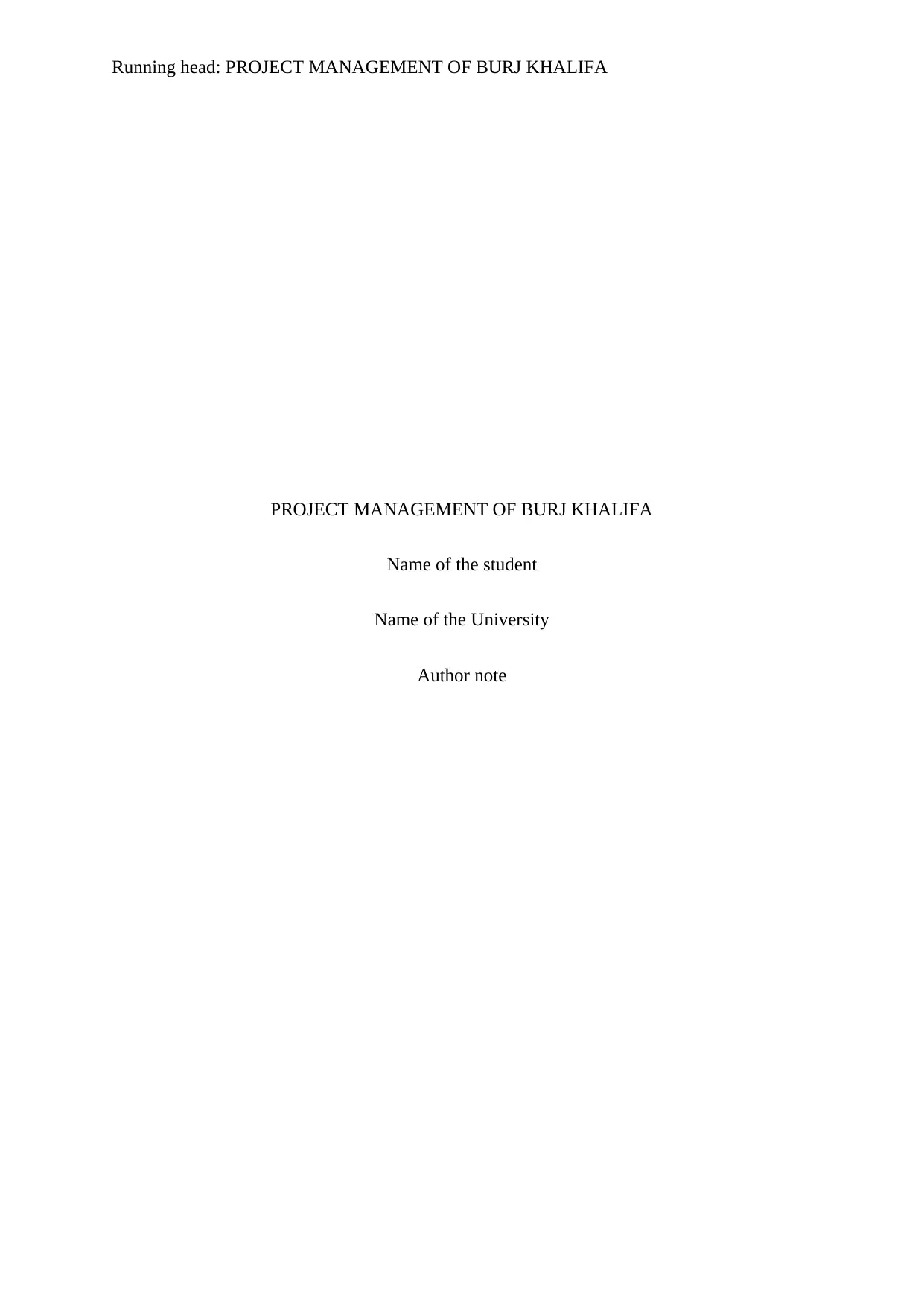
Running head: PROJECT MANAGEMENT OF BURJ KHALIFA
PROJECT MANAGEMENT OF BURJ KHALIFA
Name of the student
Name of the University
Author note
PROJECT MANAGEMENT OF BURJ KHALIFA
Name of the student
Name of the University
Author note
Paraphrase This Document
Need a fresh take? Get an instant paraphrase of this document with our AI Paraphraser
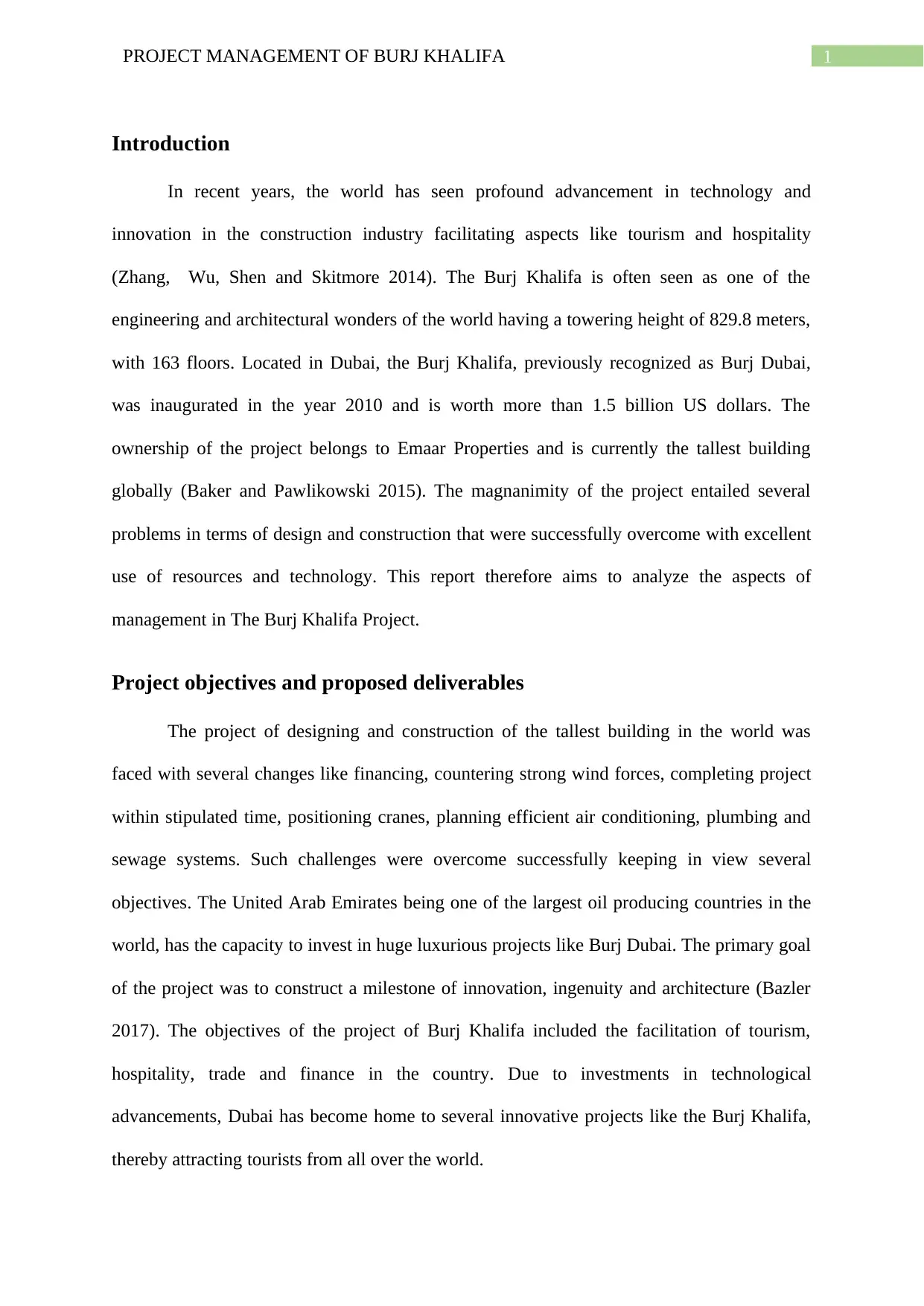
1PROJECT MANAGEMENT OF BURJ KHALIFA
Introduction
In recent years, the world has seen profound advancement in technology and
innovation in the construction industry facilitating aspects like tourism and hospitality
(Zhang, Wu, Shen and Skitmore 2014). The Burj Khalifa is often seen as one of the
engineering and architectural wonders of the world having a towering height of 829.8 meters,
with 163 floors. Located in Dubai, the Burj Khalifa, previously recognized as Burj Dubai,
was inaugurated in the year 2010 and is worth more than 1.5 billion US dollars. The
ownership of the project belongs to Emaar Properties and is currently the tallest building
globally (Baker and Pawlikowski 2015). The magnanimity of the project entailed several
problems in terms of design and construction that were successfully overcome with excellent
use of resources and technology. This report therefore aims to analyze the aspects of
management in The Burj Khalifa Project.
Project objectives and proposed deliverables
The project of designing and construction of the tallest building in the world was
faced with several changes like financing, countering strong wind forces, completing project
within stipulated time, positioning cranes, planning efficient air conditioning, plumbing and
sewage systems. Such challenges were overcome successfully keeping in view several
objectives. The United Arab Emirates being one of the largest oil producing countries in the
world, has the capacity to invest in huge luxurious projects like Burj Dubai. The primary goal
of the project was to construct a milestone of innovation, ingenuity and architecture (Bazler
2017). The objectives of the project of Burj Khalifa included the facilitation of tourism,
hospitality, trade and finance in the country. Due to investments in technological
advancements, Dubai has become home to several innovative projects like the Burj Khalifa,
thereby attracting tourists from all over the world.
Introduction
In recent years, the world has seen profound advancement in technology and
innovation in the construction industry facilitating aspects like tourism and hospitality
(Zhang, Wu, Shen and Skitmore 2014). The Burj Khalifa is often seen as one of the
engineering and architectural wonders of the world having a towering height of 829.8 meters,
with 163 floors. Located in Dubai, the Burj Khalifa, previously recognized as Burj Dubai,
was inaugurated in the year 2010 and is worth more than 1.5 billion US dollars. The
ownership of the project belongs to Emaar Properties and is currently the tallest building
globally (Baker and Pawlikowski 2015). The magnanimity of the project entailed several
problems in terms of design and construction that were successfully overcome with excellent
use of resources and technology. This report therefore aims to analyze the aspects of
management in The Burj Khalifa Project.
Project objectives and proposed deliverables
The project of designing and construction of the tallest building in the world was
faced with several changes like financing, countering strong wind forces, completing project
within stipulated time, positioning cranes, planning efficient air conditioning, plumbing and
sewage systems. Such challenges were overcome successfully keeping in view several
objectives. The United Arab Emirates being one of the largest oil producing countries in the
world, has the capacity to invest in huge luxurious projects like Burj Dubai. The primary goal
of the project was to construct a milestone of innovation, ingenuity and architecture (Bazler
2017). The objectives of the project of Burj Khalifa included the facilitation of tourism,
hospitality, trade and finance in the country. Due to investments in technological
advancements, Dubai has become home to several innovative projects like the Burj Khalifa,
thereby attracting tourists from all over the world.
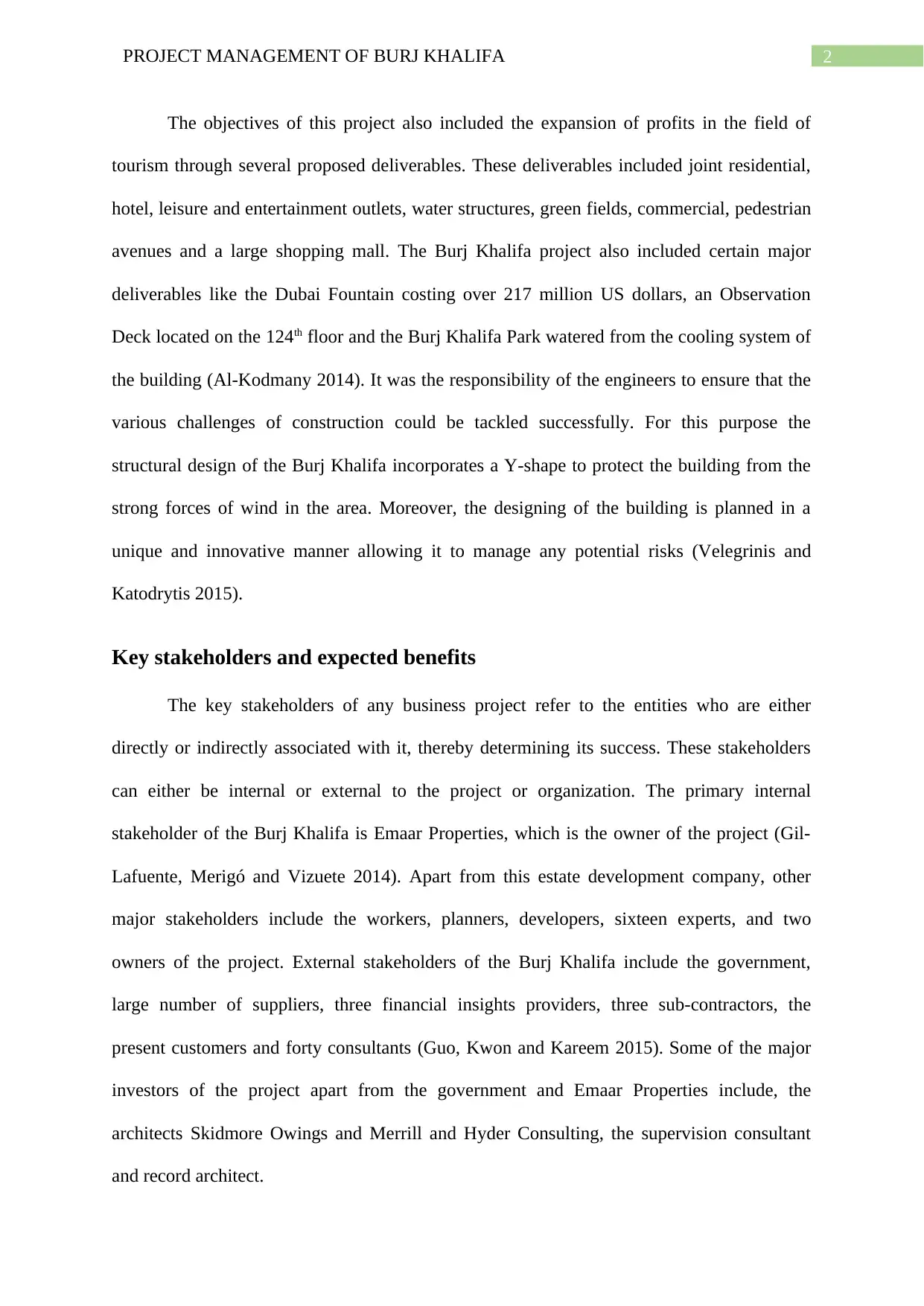
2PROJECT MANAGEMENT OF BURJ KHALIFA
The objectives of this project also included the expansion of profits in the field of
tourism through several proposed deliverables. These deliverables included joint residential,
hotel, leisure and entertainment outlets, water structures, green fields, commercial, pedestrian
avenues and a large shopping mall. The Burj Khalifa project also included certain major
deliverables like the Dubai Fountain costing over 217 million US dollars, an Observation
Deck located on the 124th floor and the Burj Khalifa Park watered from the cooling system of
the building (Al-Kodmany 2014). It was the responsibility of the engineers to ensure that the
various challenges of construction could be tackled successfully. For this purpose the
structural design of the Burj Khalifa incorporates a Y-shape to protect the building from the
strong forces of wind in the area. Moreover, the designing of the building is planned in a
unique and innovative manner allowing it to manage any potential risks (Velegrinis and
Katodrytis 2015).
Key stakeholders and expected benefits
The key stakeholders of any business project refer to the entities who are either
directly or indirectly associated with it, thereby determining its success. These stakeholders
can either be internal or external to the project or organization. The primary internal
stakeholder of the Burj Khalifa is Emaar Properties, which is the owner of the project (Gil-
Lafuente, Merigó and Vizuete 2014). Apart from this estate development company, other
major stakeholders include the workers, planners, developers, sixteen experts, and two
owners of the project. External stakeholders of the Burj Khalifa include the government,
large number of suppliers, three financial insights providers, three sub-contractors, the
present customers and forty consultants (Guo, Kwon and Kareem 2015). Some of the major
investors of the project apart from the government and Emaar Properties include, the
architects Skidmore Owings and Merrill and Hyder Consulting, the supervision consultant
and record architect.
The objectives of this project also included the expansion of profits in the field of
tourism through several proposed deliverables. These deliverables included joint residential,
hotel, leisure and entertainment outlets, water structures, green fields, commercial, pedestrian
avenues and a large shopping mall. The Burj Khalifa project also included certain major
deliverables like the Dubai Fountain costing over 217 million US dollars, an Observation
Deck located on the 124th floor and the Burj Khalifa Park watered from the cooling system of
the building (Al-Kodmany 2014). It was the responsibility of the engineers to ensure that the
various challenges of construction could be tackled successfully. For this purpose the
structural design of the Burj Khalifa incorporates a Y-shape to protect the building from the
strong forces of wind in the area. Moreover, the designing of the building is planned in a
unique and innovative manner allowing it to manage any potential risks (Velegrinis and
Katodrytis 2015).
Key stakeholders and expected benefits
The key stakeholders of any business project refer to the entities who are either
directly or indirectly associated with it, thereby determining its success. These stakeholders
can either be internal or external to the project or organization. The primary internal
stakeholder of the Burj Khalifa is Emaar Properties, which is the owner of the project (Gil-
Lafuente, Merigó and Vizuete 2014). Apart from this estate development company, other
major stakeholders include the workers, planners, developers, sixteen experts, and two
owners of the project. External stakeholders of the Burj Khalifa include the government,
large number of suppliers, three financial insights providers, three sub-contractors, the
present customers and forty consultants (Guo, Kwon and Kareem 2015). Some of the major
investors of the project apart from the government and Emaar Properties include, the
architects Skidmore Owings and Merrill and Hyder Consulting, the supervision consultant
and record architect.
⊘ This is a preview!⊘
Do you want full access?
Subscribe today to unlock all pages.

Trusted by 1+ million students worldwide
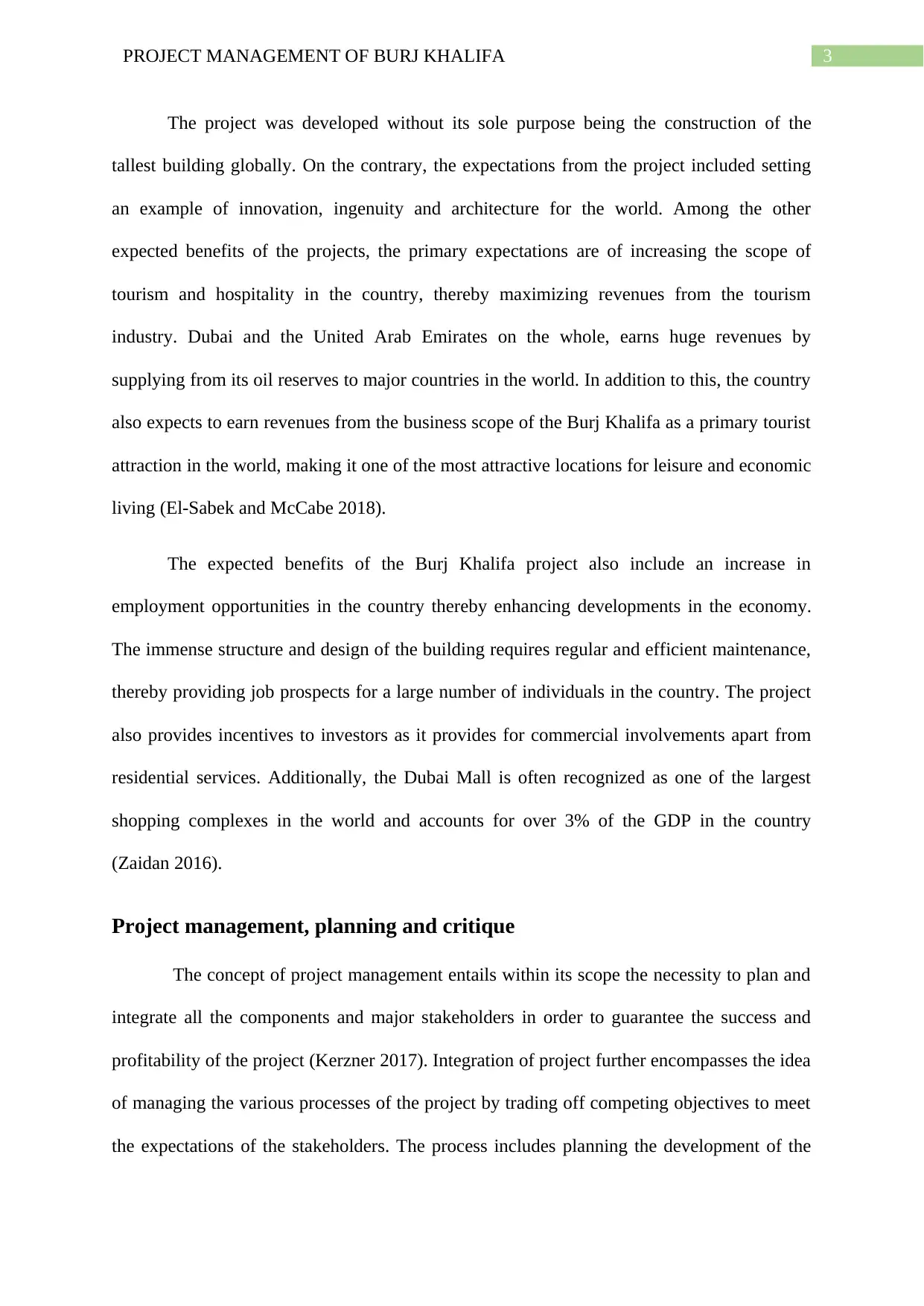
3PROJECT MANAGEMENT OF BURJ KHALIFA
The project was developed without its sole purpose being the construction of the
tallest building globally. On the contrary, the expectations from the project included setting
an example of innovation, ingenuity and architecture for the world. Among the other
expected benefits of the projects, the primary expectations are of increasing the scope of
tourism and hospitality in the country, thereby maximizing revenues from the tourism
industry. Dubai and the United Arab Emirates on the whole, earns huge revenues by
supplying from its oil reserves to major countries in the world. In addition to this, the country
also expects to earn revenues from the business scope of the Burj Khalifa as a primary tourist
attraction in the world, making it one of the most attractive locations for leisure and economic
living (El-Sabek and McCabe 2018).
The expected benefits of the Burj Khalifa project also include an increase in
employment opportunities in the country thereby enhancing developments in the economy.
The immense structure and design of the building requires regular and efficient maintenance,
thereby providing job prospects for a large number of individuals in the country. The project
also provides incentives to investors as it provides for commercial involvements apart from
residential services. Additionally, the Dubai Mall is often recognized as one of the largest
shopping complexes in the world and accounts for over 3% of the GDP in the country
(Zaidan 2016).
Project management, planning and critique
The concept of project management entails within its scope the necessity to plan and
integrate all the components and major stakeholders in order to guarantee the success and
profitability of the project (Kerzner 2017). Integration of project further encompasses the idea
of managing the various processes of the project by trading off competing objectives to meet
the expectations of the stakeholders. The process includes planning the development of the
The project was developed without its sole purpose being the construction of the
tallest building globally. On the contrary, the expectations from the project included setting
an example of innovation, ingenuity and architecture for the world. Among the other
expected benefits of the projects, the primary expectations are of increasing the scope of
tourism and hospitality in the country, thereby maximizing revenues from the tourism
industry. Dubai and the United Arab Emirates on the whole, earns huge revenues by
supplying from its oil reserves to major countries in the world. In addition to this, the country
also expects to earn revenues from the business scope of the Burj Khalifa as a primary tourist
attraction in the world, making it one of the most attractive locations for leisure and economic
living (El-Sabek and McCabe 2018).
The expected benefits of the Burj Khalifa project also include an increase in
employment opportunities in the country thereby enhancing developments in the economy.
The immense structure and design of the building requires regular and efficient maintenance,
thereby providing job prospects for a large number of individuals in the country. The project
also provides incentives to investors as it provides for commercial involvements apart from
residential services. Additionally, the Dubai Mall is often recognized as one of the largest
shopping complexes in the world and accounts for over 3% of the GDP in the country
(Zaidan 2016).
Project management, planning and critique
The concept of project management entails within its scope the necessity to plan and
integrate all the components and major stakeholders in order to guarantee the success and
profitability of the project (Kerzner 2017). Integration of project further encompasses the idea
of managing the various processes of the project by trading off competing objectives to meet
the expectations of the stakeholders. The process includes planning the development of the
Paraphrase This Document
Need a fresh take? Get an instant paraphrase of this document with our AI Paraphraser
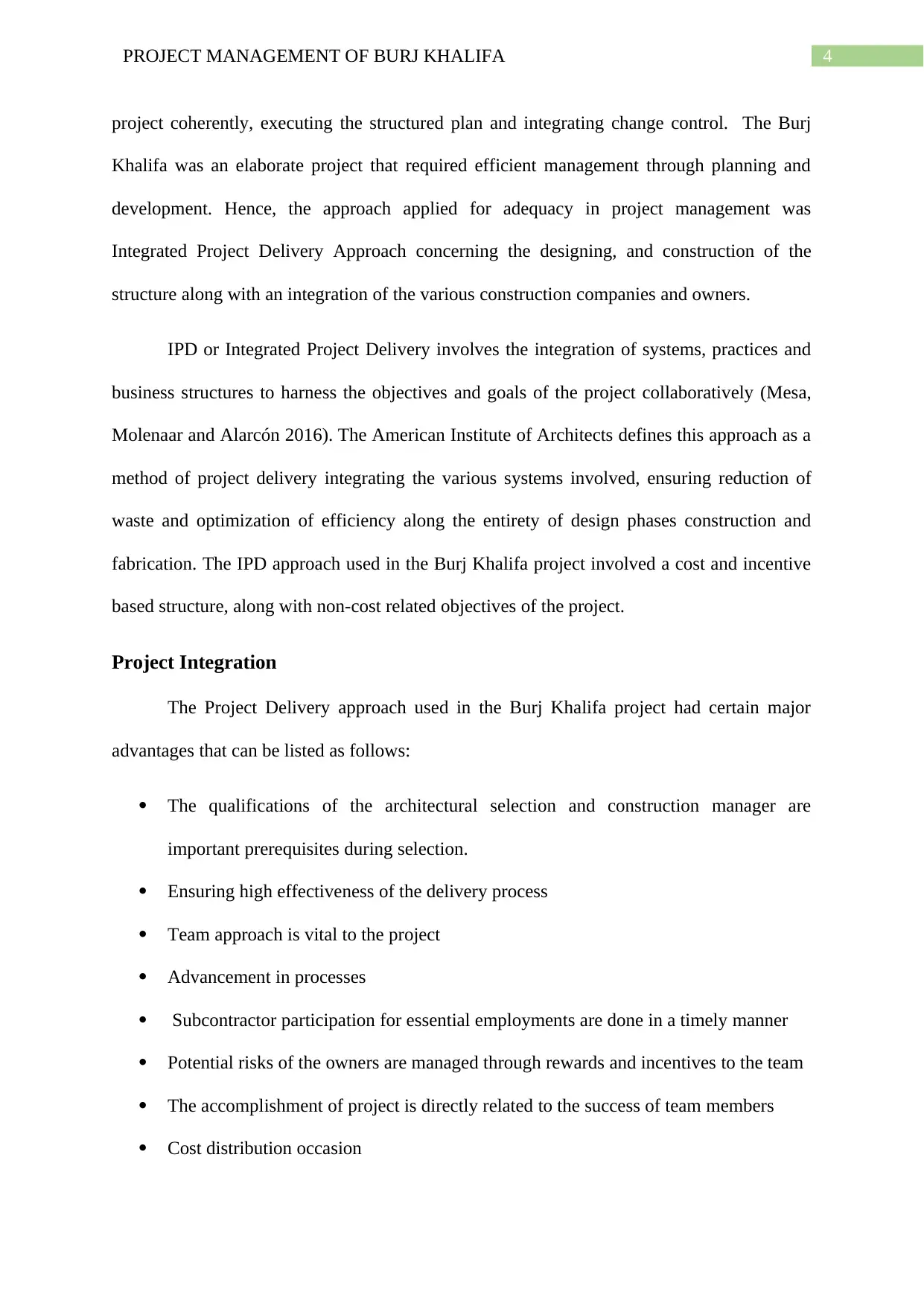
4PROJECT MANAGEMENT OF BURJ KHALIFA
project coherently, executing the structured plan and integrating change control. The Burj
Khalifa was an elaborate project that required efficient management through planning and
development. Hence, the approach applied for adequacy in project management was
Integrated Project Delivery Approach concerning the designing, and construction of the
structure along with an integration of the various construction companies and owners.
IPD or Integrated Project Delivery involves the integration of systems, practices and
business structures to harness the objectives and goals of the project collaboratively (Mesa,
Molenaar and Alarcón 2016). The American Institute of Architects defines this approach as a
method of project delivery integrating the various systems involved, ensuring reduction of
waste and optimization of efficiency along the entirety of design phases construction and
fabrication. The IPD approach used in the Burj Khalifa project involved a cost and incentive
based structure, along with non-cost related objectives of the project.
Project Integration
The Project Delivery approach used in the Burj Khalifa project had certain major
advantages that can be listed as follows:
The qualifications of the architectural selection and construction manager are
important prerequisites during selection.
Ensuring high effectiveness of the delivery process
Team approach is vital to the project
Advancement in processes
Subcontractor participation for essential employments are done in a timely manner
Potential risks of the owners are managed through rewards and incentives to the team
The accomplishment of project is directly related to the success of team members
Cost distribution occasion
project coherently, executing the structured plan and integrating change control. The Burj
Khalifa was an elaborate project that required efficient management through planning and
development. Hence, the approach applied for adequacy in project management was
Integrated Project Delivery Approach concerning the designing, and construction of the
structure along with an integration of the various construction companies and owners.
IPD or Integrated Project Delivery involves the integration of systems, practices and
business structures to harness the objectives and goals of the project collaboratively (Mesa,
Molenaar and Alarcón 2016). The American Institute of Architects defines this approach as a
method of project delivery integrating the various systems involved, ensuring reduction of
waste and optimization of efficiency along the entirety of design phases construction and
fabrication. The IPD approach used in the Burj Khalifa project involved a cost and incentive
based structure, along with non-cost related objectives of the project.
Project Integration
The Project Delivery approach used in the Burj Khalifa project had certain major
advantages that can be listed as follows:
The qualifications of the architectural selection and construction manager are
important prerequisites during selection.
Ensuring high effectiveness of the delivery process
Team approach is vital to the project
Advancement in processes
Subcontractor participation for essential employments are done in a timely manner
Potential risks of the owners are managed through rewards and incentives to the team
The accomplishment of project is directly related to the success of team members
Cost distribution occasion
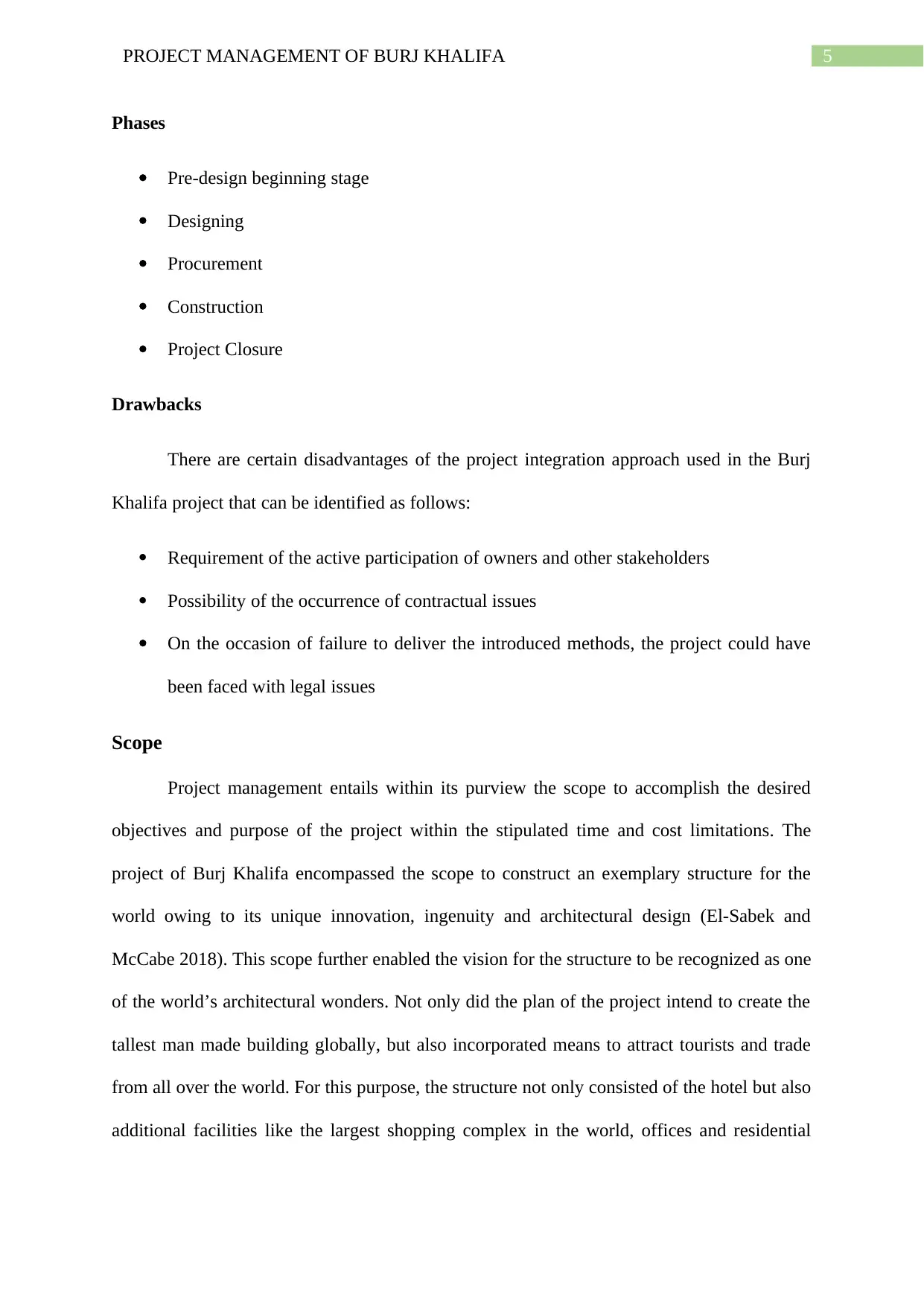
5PROJECT MANAGEMENT OF BURJ KHALIFA
Phases
Pre-design beginning stage
Designing
Procurement
Construction
Project Closure
Drawbacks
There are certain disadvantages of the project integration approach used in the Burj
Khalifa project that can be identified as follows:
Requirement of the active participation of owners and other stakeholders
Possibility of the occurrence of contractual issues
On the occasion of failure to deliver the introduced methods, the project could have
been faced with legal issues
Scope
Project management entails within its purview the scope to accomplish the desired
objectives and purpose of the project within the stipulated time and cost limitations. The
project of Burj Khalifa encompassed the scope to construct an exemplary structure for the
world owing to its unique innovation, ingenuity and architectural design (El-Sabek and
McCabe 2018). This scope further enabled the vision for the structure to be recognized as one
of the world’s architectural wonders. Not only did the plan of the project intend to create the
tallest man made building globally, but also incorporated means to attract tourists and trade
from all over the world. For this purpose, the structure not only consisted of the hotel but also
additional facilities like the largest shopping complex in the world, offices and residential
Phases
Pre-design beginning stage
Designing
Procurement
Construction
Project Closure
Drawbacks
There are certain disadvantages of the project integration approach used in the Burj
Khalifa project that can be identified as follows:
Requirement of the active participation of owners and other stakeholders
Possibility of the occurrence of contractual issues
On the occasion of failure to deliver the introduced methods, the project could have
been faced with legal issues
Scope
Project management entails within its purview the scope to accomplish the desired
objectives and purpose of the project within the stipulated time and cost limitations. The
project of Burj Khalifa encompassed the scope to construct an exemplary structure for the
world owing to its unique innovation, ingenuity and architectural design (El-Sabek and
McCabe 2018). This scope further enabled the vision for the structure to be recognized as one
of the world’s architectural wonders. Not only did the plan of the project intend to create the
tallest man made building globally, but also incorporated means to attract tourists and trade
from all over the world. For this purpose, the structure not only consisted of the hotel but also
additional facilities like the largest shopping complex in the world, offices and residential
⊘ This is a preview!⊘
Do you want full access?
Subscribe today to unlock all pages.

Trusted by 1+ million students worldwide
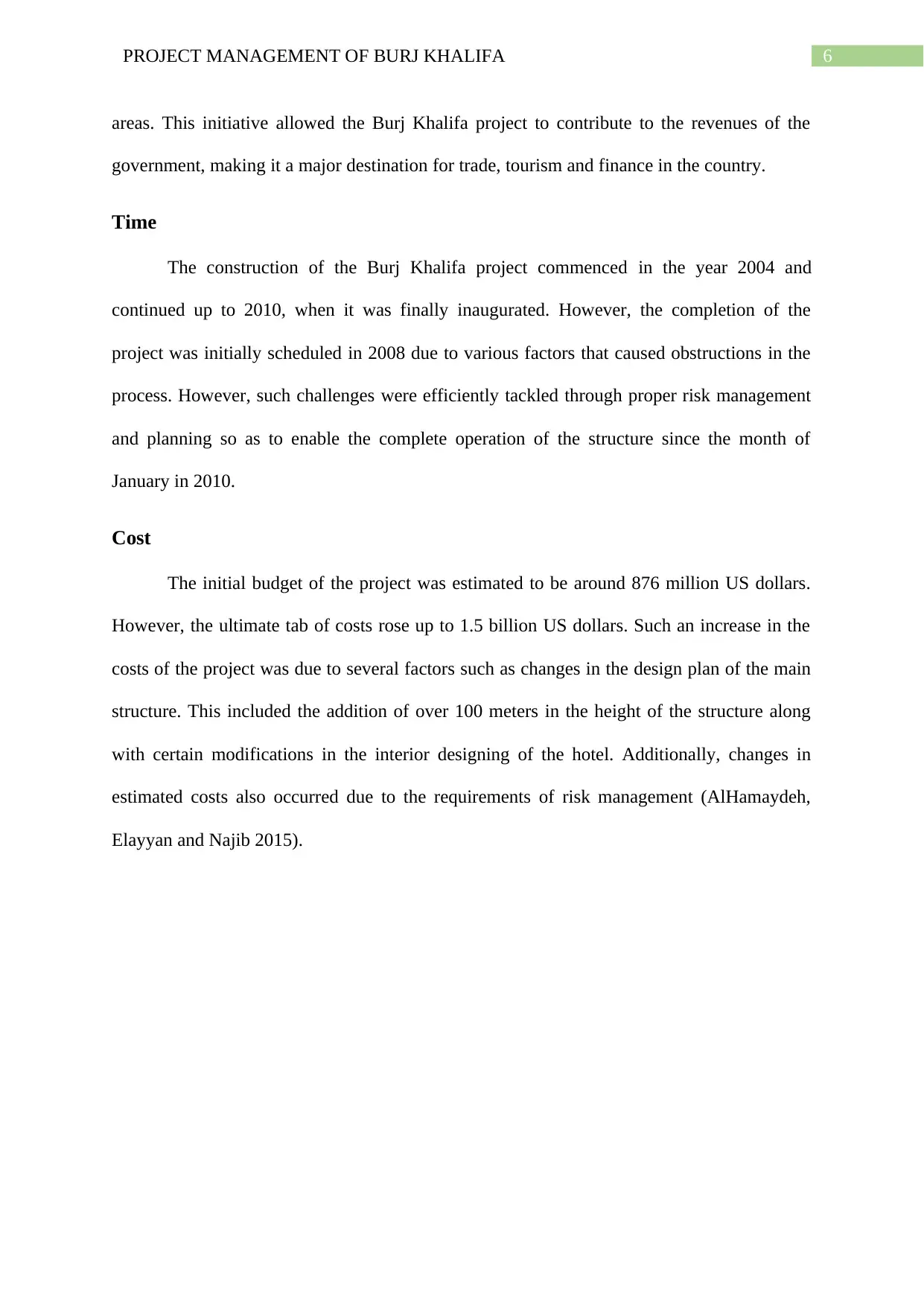
6PROJECT MANAGEMENT OF BURJ KHALIFA
areas. This initiative allowed the Burj Khalifa project to contribute to the revenues of the
government, making it a major destination for trade, tourism and finance in the country.
Time
The construction of the Burj Khalifa project commenced in the year 2004 and
continued up to 2010, when it was finally inaugurated. However, the completion of the
project was initially scheduled in 2008 due to various factors that caused obstructions in the
process. However, such challenges were efficiently tackled through proper risk management
and planning so as to enable the complete operation of the structure since the month of
January in 2010.
Cost
The initial budget of the project was estimated to be around 876 million US dollars.
However, the ultimate tab of costs rose up to 1.5 billion US dollars. Such an increase in the
costs of the project was due to several factors such as changes in the design plan of the main
structure. This included the addition of over 100 meters in the height of the structure along
with certain modifications in the interior designing of the hotel. Additionally, changes in
estimated costs also occurred due to the requirements of risk management (AlHamaydeh,
Elayyan and Najib 2015).
areas. This initiative allowed the Burj Khalifa project to contribute to the revenues of the
government, making it a major destination for trade, tourism and finance in the country.
Time
The construction of the Burj Khalifa project commenced in the year 2004 and
continued up to 2010, when it was finally inaugurated. However, the completion of the
project was initially scheduled in 2008 due to various factors that caused obstructions in the
process. However, such challenges were efficiently tackled through proper risk management
and planning so as to enable the complete operation of the structure since the month of
January in 2010.
Cost
The initial budget of the project was estimated to be around 876 million US dollars.
However, the ultimate tab of costs rose up to 1.5 billion US dollars. Such an increase in the
costs of the project was due to several factors such as changes in the design plan of the main
structure. This included the addition of over 100 meters in the height of the structure along
with certain modifications in the interior designing of the hotel. Additionally, changes in
estimated costs also occurred due to the requirements of risk management (AlHamaydeh,
Elayyan and Najib 2015).
Paraphrase This Document
Need a fresh take? Get an instant paraphrase of this document with our AI Paraphraser
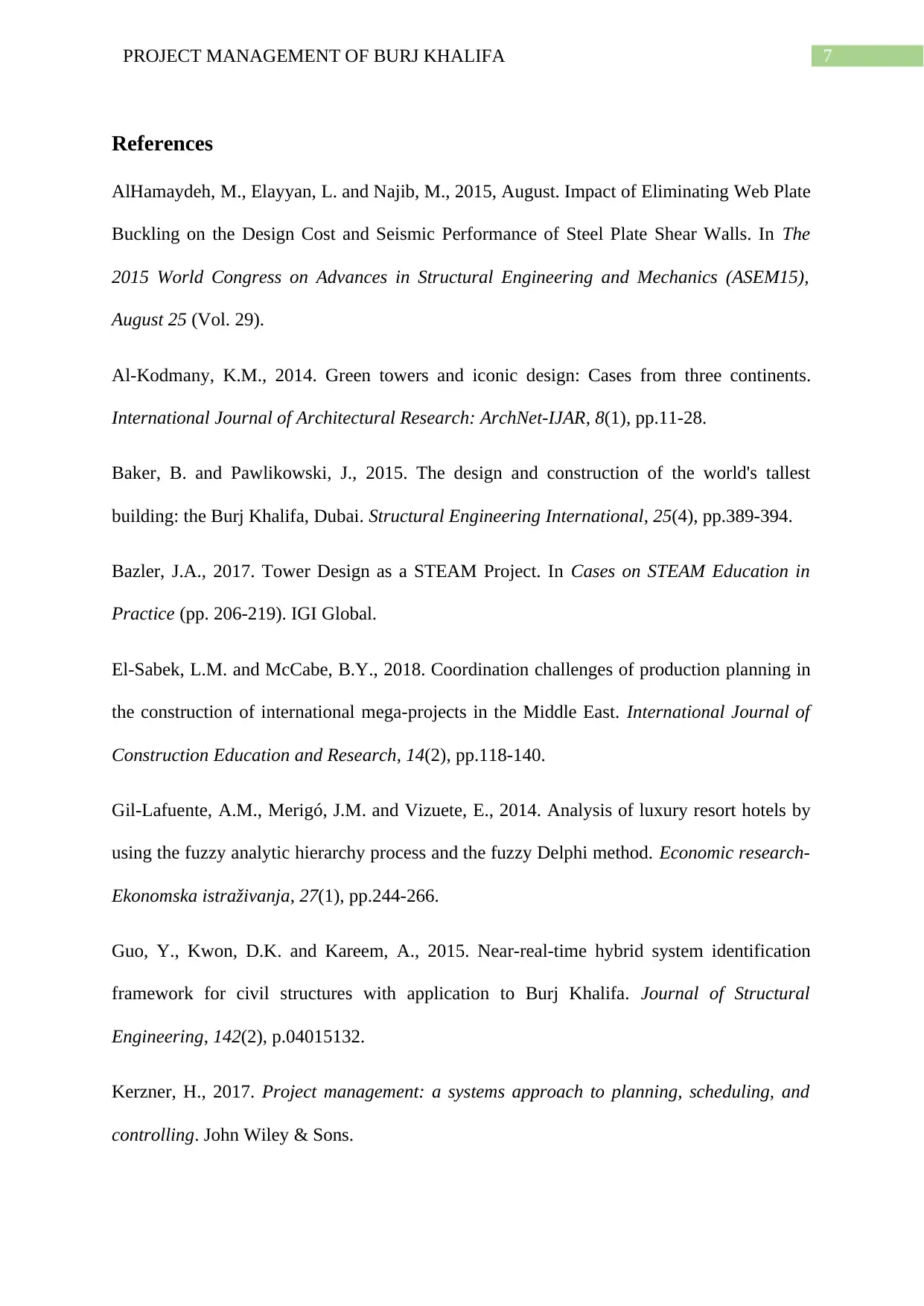
7PROJECT MANAGEMENT OF BURJ KHALIFA
References
AlHamaydeh, M., Elayyan, L. and Najib, M., 2015, August. Impact of Eliminating Web Plate
Buckling on the Design Cost and Seismic Performance of Steel Plate Shear Walls. In The
2015 World Congress on Advances in Structural Engineering and Mechanics (ASEM15),
August 25 (Vol. 29).
Al-Kodmany, K.M., 2014. Green towers and iconic design: Cases from three continents.
International Journal of Architectural Research: ArchNet-IJAR, 8(1), pp.11-28.
Baker, B. and Pawlikowski, J., 2015. The design and construction of the world's tallest
building: the Burj Khalifa, Dubai. Structural Engineering International, 25(4), pp.389-394.
Bazler, J.A., 2017. Tower Design as a STEAM Project. In Cases on STEAM Education in
Practice (pp. 206-219). IGI Global.
El-Sabek, L.M. and McCabe, B.Y., 2018. Coordination challenges of production planning in
the construction of international mega-projects in the Middle East. International Journal of
Construction Education and Research, 14(2), pp.118-140.
Gil-Lafuente, A.M., Merigó, J.M. and Vizuete, E., 2014. Analysis of luxury resort hotels by
using the fuzzy analytic hierarchy process and the fuzzy Delphi method. Economic research-
Ekonomska istraživanja, 27(1), pp.244-266.
Guo, Y., Kwon, D.K. and Kareem, A., 2015. Near-real-time hybrid system identification
framework for civil structures with application to Burj Khalifa. Journal of Structural
Engineering, 142(2), p.04015132.
Kerzner, H., 2017. Project management: a systems approach to planning, scheduling, and
controlling. John Wiley & Sons.
References
AlHamaydeh, M., Elayyan, L. and Najib, M., 2015, August. Impact of Eliminating Web Plate
Buckling on the Design Cost and Seismic Performance of Steel Plate Shear Walls. In The
2015 World Congress on Advances in Structural Engineering and Mechanics (ASEM15),
August 25 (Vol. 29).
Al-Kodmany, K.M., 2014. Green towers and iconic design: Cases from three continents.
International Journal of Architectural Research: ArchNet-IJAR, 8(1), pp.11-28.
Baker, B. and Pawlikowski, J., 2015. The design and construction of the world's tallest
building: the Burj Khalifa, Dubai. Structural Engineering International, 25(4), pp.389-394.
Bazler, J.A., 2017. Tower Design as a STEAM Project. In Cases on STEAM Education in
Practice (pp. 206-219). IGI Global.
El-Sabek, L.M. and McCabe, B.Y., 2018. Coordination challenges of production planning in
the construction of international mega-projects in the Middle East. International Journal of
Construction Education and Research, 14(2), pp.118-140.
Gil-Lafuente, A.M., Merigó, J.M. and Vizuete, E., 2014. Analysis of luxury resort hotels by
using the fuzzy analytic hierarchy process and the fuzzy Delphi method. Economic research-
Ekonomska istraživanja, 27(1), pp.244-266.
Guo, Y., Kwon, D.K. and Kareem, A., 2015. Near-real-time hybrid system identification
framework for civil structures with application to Burj Khalifa. Journal of Structural
Engineering, 142(2), p.04015132.
Kerzner, H., 2017. Project management: a systems approach to planning, scheduling, and
controlling. John Wiley & Sons.
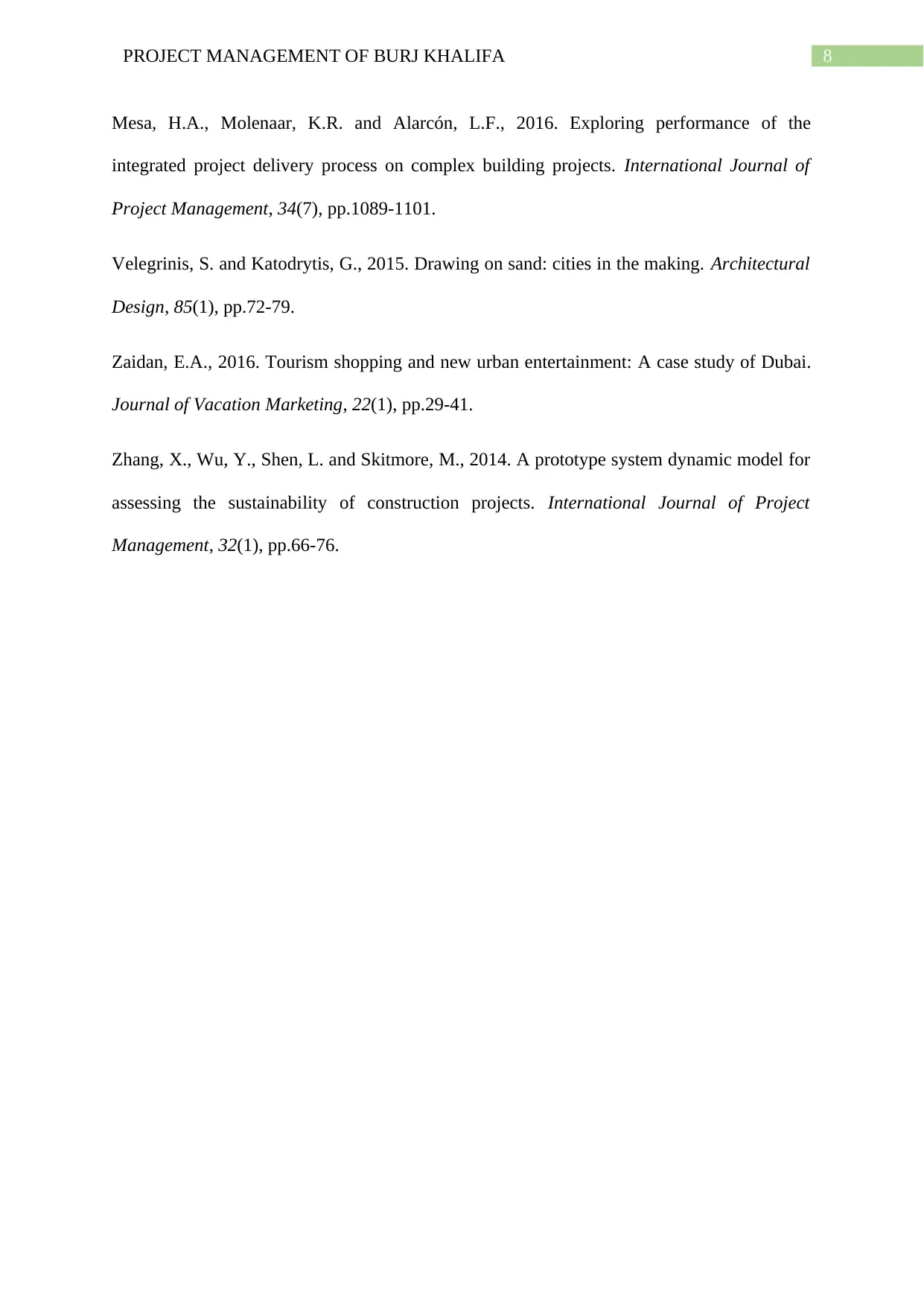
8PROJECT MANAGEMENT OF BURJ KHALIFA
Mesa, H.A., Molenaar, K.R. and Alarcón, L.F., 2016. Exploring performance of the
integrated project delivery process on complex building projects. International Journal of
Project Management, 34(7), pp.1089-1101.
Velegrinis, S. and Katodrytis, G., 2015. Drawing on sand: cities in the making. Architectural
Design, 85(1), pp.72-79.
Zaidan, E.A., 2016. Tourism shopping and new urban entertainment: A case study of Dubai.
Journal of Vacation Marketing, 22(1), pp.29-41.
Zhang, X., Wu, Y., Shen, L. and Skitmore, M., 2014. A prototype system dynamic model for
assessing the sustainability of construction projects. International Journal of Project
Management, 32(1), pp.66-76.
Mesa, H.A., Molenaar, K.R. and Alarcón, L.F., 2016. Exploring performance of the
integrated project delivery process on complex building projects. International Journal of
Project Management, 34(7), pp.1089-1101.
Velegrinis, S. and Katodrytis, G., 2015. Drawing on sand: cities in the making. Architectural
Design, 85(1), pp.72-79.
Zaidan, E.A., 2016. Tourism shopping and new urban entertainment: A case study of Dubai.
Journal of Vacation Marketing, 22(1), pp.29-41.
Zhang, X., Wu, Y., Shen, L. and Skitmore, M., 2014. A prototype system dynamic model for
assessing the sustainability of construction projects. International Journal of Project
Management, 32(1), pp.66-76.
⊘ This is a preview!⊘
Do you want full access?
Subscribe today to unlock all pages.

Trusted by 1+ million students worldwide
1 out of 9
Related Documents
Your All-in-One AI-Powered Toolkit for Academic Success.
+13062052269
info@desklib.com
Available 24*7 on WhatsApp / Email
![[object Object]](/_next/static/media/star-bottom.7253800d.svg)
Unlock your academic potential
Copyright © 2020–2025 A2Z Services. All Rights Reserved. Developed and managed by ZUCOL.





